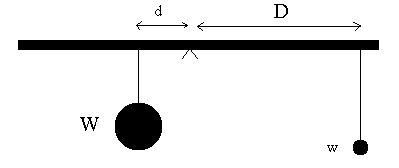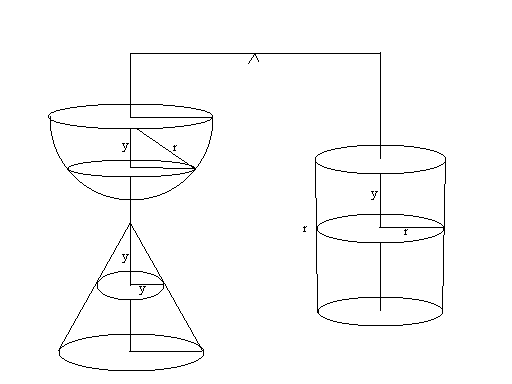The genius of Archimedes
There is no historical accuracy in what follows,
although Archimedes certainly developed the methods whose modern reconstruction I describe
below. I first came across these matters in George Pólya's splendid two-volume work
"Mathematics and Plausible Reasoning" (Princeton University Press, paperback editions 1990).
Proper historical information is given in Sherman Stein's fascinating book "Archimedes:
what did he do besides cry Eureka?" (The Mathematical Association of America, 1999).
|
Archimedes' genius must have been in relating
physical observations to more abstract mathematical ideas.
For instance, the kind of beam balance illustrated on the right shows that a small weight
can counterbalance a larger one provided it is further away from the fulcrum. More precisely,
experiment shows that the weights will balance provided Wd = wD. The apparatus can be used
as a very handy device for measuring weight.
|

|
Archimedes was very interested in determining
the volumes and surface areas of various solid figures. Cubes and cylinders are easy, but
what about a sphere? It is a beautifully simple object in some ways, but how on earth could
you work out its volume? Archimedes realised that there was an extraordinary connection with
the beam balance, as shown below:

|
A hemisphere and a cone can balance a cylinder at the same distance on the other side of
the fulcrum. The reasoning goes like this. Think of an incredibly thin slice of the
hemisphere at a distance y below its equator. If the hemisphere has a radius r, then the
square of the radius of the slice, according to Pythagoras' Theorem, will be
r2
- y2.
|
The area of the slice will thus be π(r2
- y2). The cone is sized so that at a distance of y down from its vertex, the
radius of a slice will also be y, so that the area of that slice will be πy2.
If we imagine the two slices as very thin circles of some substance, then their combined
weight would be proportional to πr2. This amounts to the weight of a slice
through the cylinder on the other side of the fulcrum. Think of successive slices from the
top to the bottom of the hemisphere and of the cone, balanced by slices through the cylinder
on the other side. We end up with a solid hemisphere and a cone hanging below it, balancing
a solid cylinder. When all the slices are put together, y has run from 0 to r, so the cone
and the cylinder will both have a height r, while the cylinder has a radius r, and the
cone a base radius r. The volume of the cylinder is instantly seen to be πr3,
and that must be the sum of the volumes of the hemisphere and the cone - but what is the
volume of a cone? We've got a bit closer to finding the volume of a sphere, but we're not
quite there yet.
|
In the diagram on the right, we have a cone of height h
and base radius r at unit distance from the fulcrum. The thin slice at a distance y down
from the apex has a radius x, and thus a weight proportional to πx2.
|

|
On the
other side of the fulcrum is a triangular slab. At a distance y from its apex a slice of
length x is shown: we want to adjust the thickness of the triangular slab so that its
weight multiplied by y is πx2. This will ensure that the slice of the triangle
balances that of the cone. Similar triangles in the cone show that y/x = h/r, or in other
words,
y = hx/r. If we make the thickness of the slab πr/h, its weight will be
proportional to πrx/h. Multiplying by y, or hx/r, we obtain
πrx/h . hx/r = πx
2, as required.
As y goes from 0 to h, we see that the final length
of the triangular slab becomes h, and its base r. The area of its triangular face is thus
hr/2 (half the base times the vertical height), and its overall weight will be proportional
to hr/2 . πr/h
or πr2/2. This weight just balances the cone, but the problem remains, where is
the centre of gravity of the triangle? There is no problem about the CG of the cone, because
no matter exactly where it is, it has to be somewhere below the point from which the cone is
hanging. If C is the volume of the cone, its weight is proportional to C, so C times the
distance of the cone's point of attachment from the fulcrum, which we fixed as unity, must equal
the volume of the triangular slab, πr2/2, times the distance from the fulcrum
of the CG of the slab, through which its weight appears to act. What is this distance?
|

|
In the
diagram on the left, look at the triangle ABC for a moment, and ignore the other letters and
lines. Then check the line AX, which joins the vertex A to the middle of the opposite side
BC.
|
Such a line is called a median of the triangle. Clearly the median divides the triangle
into two parts of the same area, and thus the same weight, if the triangle has a certain
thickness. For the two triangles ABX and AXC have equal bases, BX and XC, and the same
vertical height, up from BC to A. That means that the centre of gravity of the triangle
must lie somewhere along the median. In fact the CG must be where the medians meet: if the
idea of a CG is correct, all three medians must meet at the same point, the CG itself. Well,
two of them certainly must meet at a point: draw another median BY and let AX and BY meet
at M. (Keep ignoring the other points and lines for a moment.) Next draw a line from C to
pass through M, and continue it so that it crosses AB at Z, and keep it going to reach a
point H, such that BH is parallel to XA. Now CX is equal to XB, and XM is parallel to BH,
which means that CM is equal to MH, according to a well-known property of triangles. But CY
is also equal to YA, so by the converse of that same triangle property, YM, and thus YB, is
parallel to AH. AHBM is a parallelogram, therefore. The diagonals of a parallelogram bisect
each other, so AZ = ZB, meaning that CZ really is the third median, and that M is the point
where all three medians meet, just like we wanted. Furthermore, HZ = ZM, so since HM = MC,
ZM is half of MC. Thus CM is two thirds of CZ: from a vertex of the triangle to the point
where the medians meet is two thirds of the whole median. That rather elegant proof is due to
Dani Rubinstein, and I found it at www.cut-the-knot.org/triangle/medians.shtml. The Cut the Knot website in general is a great source of mathematical pleasures.
Anyway, back at last to the volume of the cone
problem. We had established that the weight of the triangular slab was proportional to
πr2/2, and now we know that its CG is at a distance 2/3 h from the fulcrum. Thus
C . 1 = πr2/2 . 2h/3, so C = πr2h/3. The volume of a cone is one
third of its base area multiplied by its height.
And finally the sphere! We found before that a hemisphere
and a cone will balance a cylinder of volume πr3 at the same distance from the
fulcrum. The cone had a height r as well as a base radius of r, so its volume is πr
3/3. If we call the volume of the sphere V, then the volume of a hemisphere will
be V/2. So we have altogether V/2 + πr3/3 = πr3, and thus
V/2 = 2πr3/3, and V = 4πr3/3. The volume of a sphere is four
thirds pi times the cube of its radius. And it was calculated by thinking about a couple of
imaginary weighings on a beam balance and the geometry of a triangle!



